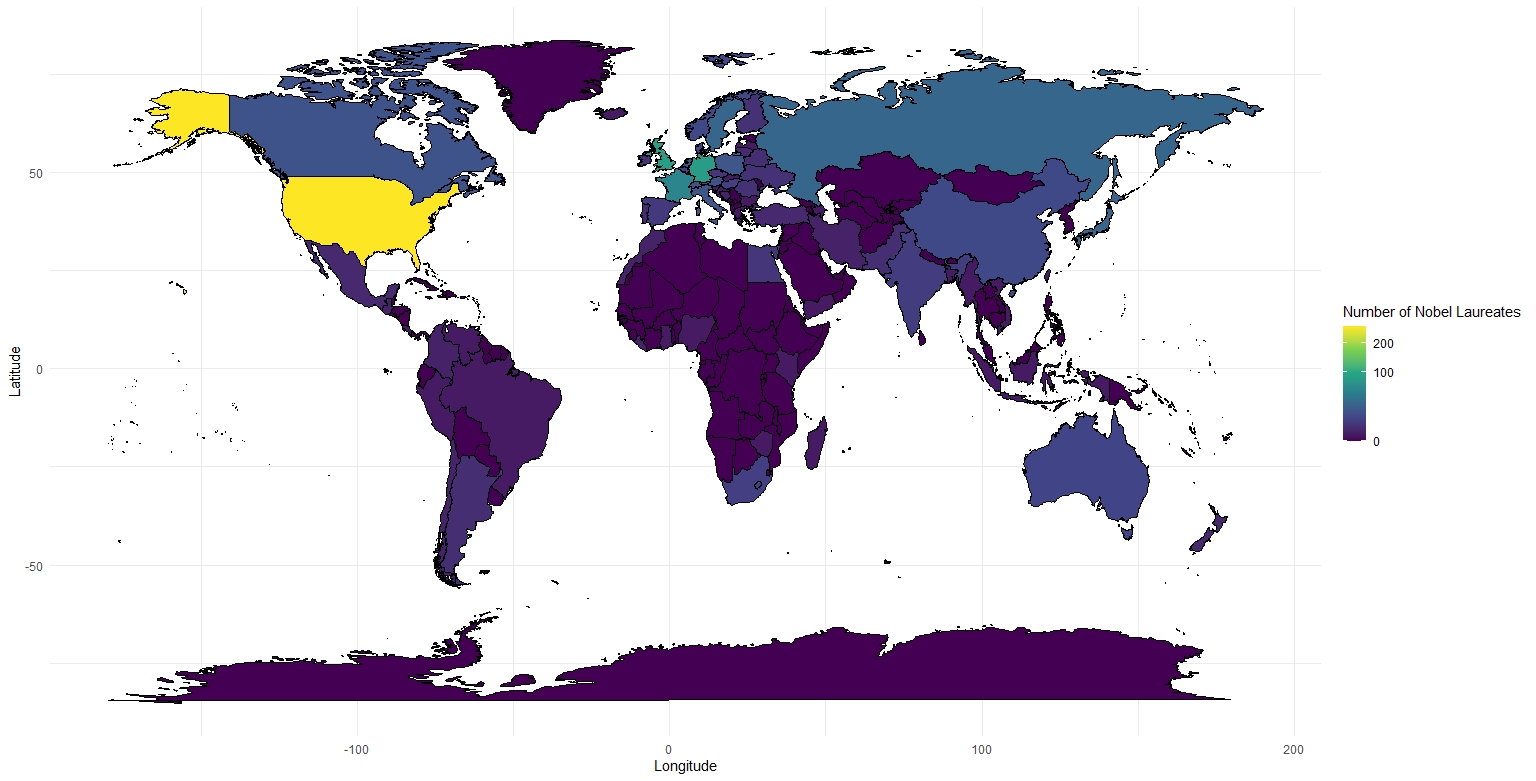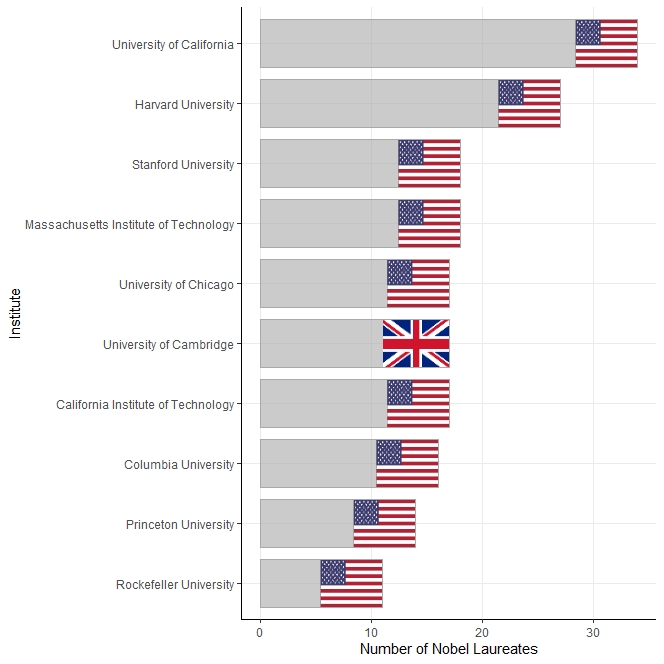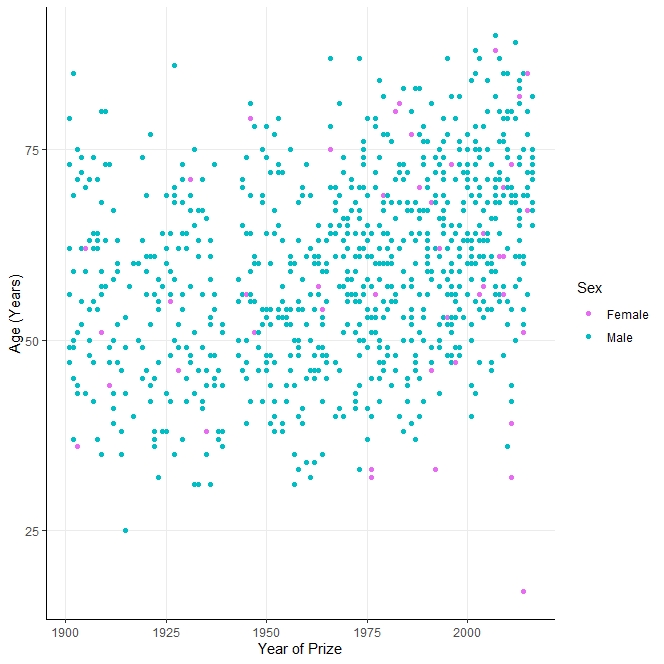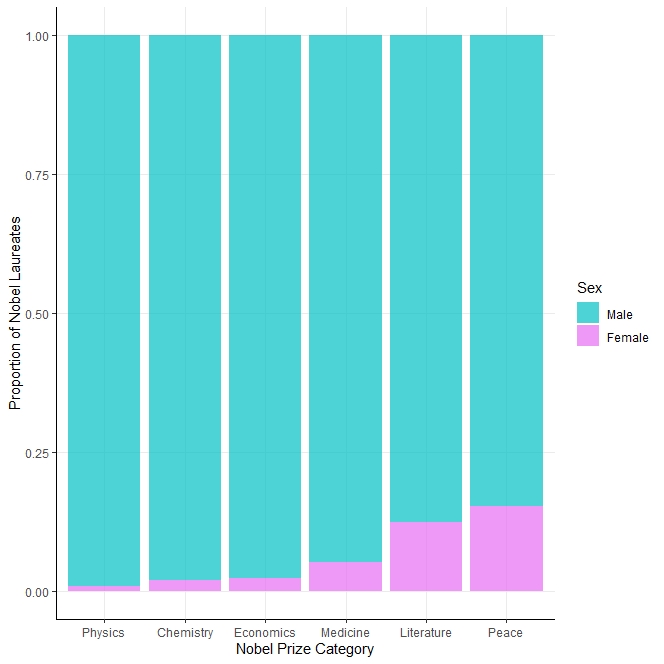The Nobel Prize is perhaps the most famous award for academic achievement, particularly within the sciences. With its great influence comes great controversy1, but what does the data say about how fairly the Nobel Prize is awarded?
A Brief History
The Nobel Prize is the legacy of the multi-talented Swedish inventor Alfred Nobel (1833-1896) who dedicated most of his endowment to award “prizes to those who, during the preceding year, have conferred the greatest benefit to humankind”. The Prizes, as outlined in Nobel’s will, are awarded each year and include the Nobel Prize for Chemistry, Medicine or Physiology, Physics, Literature, and Peace2. In 1968, an additional award was established: the Nobel Prize in Economic Sciences3.
How are Nobel Prizes awarded?
Each Nobel Prize has a specialised Nobel Committee assembled by the Royal Swedish Academy of Sciences. It is this Committee that, assisted by subject experts from the Academy, reviews a number of nominees put forward by their invited colleagues from research institutes around the world. The winner is ultimately selected from the final candidates by a majority vote from the Academy4. The Nobel Laureate receives a Nobel Medal, Diploma, and a prize amount of 10 million Swedish kronor (in 2021, ~£846,000)5.
1. Have a strong early career research output
For many of us, the Nobel Prize conjures an image of a lone genius scientist working fervently on their experiments to produce some ground-breaking research or invention. It is also commonly thought that scientists destined to become Nobel Laureates come up with these revolutionary ideas at a young professional age, owing to their extraordinary scientific intellect otherwise known as the “sacred spark”6..
Figures 1 and 2 examine this common notion by comparing the early career (within 15 years of their first paper) research output of Laureate and Non-Laureate scientists working in the Chemistry, Medicine/Physiology, and Physics fields from 1901 to 20167, 8. Figure 1 shows us that the distribution of the total number of papers published appears relatively similar between Nobel Laureates and Non-Laureates in their early career stages. The larger number of upper distribution outliers for the Non-Laureate researchers (grey points outside of the boxplot) is reflective of the much greater sample size in the Non-Laureate publication dataset (n = 41,427)8 compared to the publication dataset of Nobel Laureates (n = 548)7.

Figure 1. The distribution of papers published by Nobel Laureate and Non-Laureate early career scientists (1901-2016).
Early-career scientists are defined as being in their first 15 years since their first published paper. Note the much larger sample size of the Non-Laureate dataset (n = 41, 427)8 compared to the Nobel Laureate dataset (n = 548)7.
Figure 2 shows a slightly different story about the early research career of Nobel Laureates. There is evidence here that Nobel Laureates in Chemistry and Medicine or Physiology have significantly more papers published during their early career, on average, compared to Non-Laureates working in the same field. The 95% confidence intervals do not overlap for these researcher categories, hence we have “95% confidence” that the true mean number of papers is higher for Nobel Laureates compared to Non-Laureates9. Certainly, the same cannot be said for the Physics Laureates and Non-Laureates which have more similar mean numbers of papers. Whilst this does suggest that Nobel Laureates in Chemistry and Medicine or Physiology publish more frequently in their early careers compared to their Non-Laureate counterparts, we cannot assess the quality or impact of these papers as the dataset does not give us any citation statistics7.

Figure 2. A comparison of the mean number of papers published by Nobel Laureate and Non-Laureate early career scientists (1901-2016).
Early-career scientists are defined as being in their first 15 years since their first published paper. Bars represent 95% confidence intervals, the interval in which 95% of mean value estimates are expected to fall9. Publication dataset for Nobel Laureates here7 and for Non-Laureates from here8.
Figure 3 gives a visual representation of the journals that Nobel Prize-winning papers tend to be published in, which typically occurs during the early career of the Laureate6. It is unsurprising to see a dominance of the famous “big three” journals here (Nature, Cell, and Science) as they often pick up the most exciting research.

Figure 3. Journal frequency of prize-winning papers for the Nobel Prize in Chemistry (top), Medicine or Physiology (middle) and Physics (bottom) (1901-2016).
Note the dominance of Nature, Cell, and Science journals for the Nobel Prize in Chemistry and Medicine or Physiology. The Nobel Prize-winning paper dataset is available here7.
It seems fair to say that at least in terms of research output or papers, Nobel Laureates in the sciences do tend to have extraordinary early careers which could reflect their speculated “sacred spark” of intellect6. However, the idea of a lone genius winning these awards appears to be a common misconception. In fact, the research papers produced by Nobel Laureates tend to be produced by larger teams than those of Non-Laureates10. Similarly, Nobel Prize Nominees tend to progress faster to selection over multiple nominations when they share a prize with their colleagues11. Science, and particularly ground-breaking science, is collaborative and multidisciplinary therefore awarding the Nobel Prize to an individual may reinforce the myth that Nobel Laureates are geniuses that work alone1.
2. Work at an American institute
Other than career statistics, we can also look at the nationality and workplaces of Nobel Laureates, which is often considered a point of national pride11. The dataset here provides background (sex, nationality, age) information on Nobel Laureates in all 6 Nobel Prize categories between 1901 and 201612. The world map of birth countries of Nobel Laureates in Figure 4 shows significant skew towards the Western world, particularly to the USA – note the gradient scale in the legend. Figure 5 shows a similar story, with American institutes making up 9 of the top 10 institutes for producing Nobel Laureates. These 9 American institutes account for 172 of the 943 (18%) Nobel Laureates in the dataset12.

Figure 4. All Nobel Laureates by birth country (1901-2016).
The vast majority of Nobel Laureates are born in Western Europe or the USA. The dataset on the background of Nobel Laureates is available here12.

Figure 5. The top ten institutes for producing Nobel Prize Laureates (1901-2016).
The 9 American institutes featured above account for 18% of all Nobel Prizes awarded. The dataset on the background of Nobel Laureates is available here12.
That is not to say that citizens of countries outside the USA do not make meaningful contributions to scientific progress, but rather that their research does not get recognition through the Nobel Prize as often. Even large, well-funded countries producing cutting-edge research that lie outside the West, such as China and Brazil, produce comparatively few Nobel Laureates1. On this discrepancy, it is interesting to note that one statistical model of Nobel Laureate selection from Nominees predicts that performing research in a developed country and with living Nobel Laureates as colleagues at the same institute will speed up the winning of an award for a repeat Nominee11.
3. Be a middle-aged man
The same dataset of the backgrounds of Nobel Laureates, including winners of the Nobel Prize for Peace, Literature, and the Nobel Prize in Economic Sciences, allows us to expose any trends in age and sex12.
Figure 6 depicts a scatter graph of the ages and sex of Nobel Laureates across all categories since its beginning in 1901. A mean age of 59.5 years demonstrates that the average Nobel Laureate is middle-aged, although the standard deviation of 12.4 years shows decent variation in age across award years and prize categories12. However, the vast majority of Nobel Laureates are in their late twenties or early thirties when they perform their award-winning research6. This relatively old mean age of Nobel Laureates, therefore, points to a significant lag between the Prize-winning work and actually receiving the award. On top of this time lag, the Nobel Prize cannot be awarded posthumously so many Laureates will be elderly (rather than deceased) before they receive the award for their previous research1, 6. Statistical analysis of available Nobel Nominee data suggests that the Nobel Committee partially counteracts the bias for older Nominees during the selection process by a slight preference for younger individuals out of the Nominees11.

Figure 6. The distribution of sex and ages across all Nobel Laureates (1901-2016).
Note that the average Nobel Laureate may be getting older and there is a clear lack of representation of female academics and activists. The dataset on the background of Nobel Laureates is available here12.
Figure 7 illustrates the striking gender disparity in Nobel Laureates amongst all 6 categories of the award. For the Nobel Peace Prize, which has the greatest proportion of female Laureates, only 15.4% of Laureates since 1901 were female12. This gap is in spite of a relatively recent increase in representation of women in science, and indeed academia in general, with women now making up a predicted 52% of the science, engineering, and medical workforce. Prior to the 1960s, the gender gap in Nobel Laureates could have been due to fewer women in the appropriate fields to be put forward as Nominees, but now with more equal proportions of female to male academics, the cause of this disparity remains unclear13. Indeed, one predictive statistical model based on the gender distribution of scientific Nobel laureates estimated a 96% likelihood of bias against women winning a Nobel Prize14.

Figure 7. The proportion of male and female Laureates for each Nobel Prize (1901-2016).
The representation of women amongst Nobel Prize laureates is far from fair. The dataset on the background of Nobel Laureates is available here12.
One reasonable explanation is that the gender bias of social care, with women performing the majority of unpaid childcare and care for elderly relatives15, limits the potential for many female scientists to commit the time and resources required for Nobel Prize-winning research13. This is supported by findings that female Laureates are significantly less likely to have children and to be married than male Laureates. When a female Laureate does have children, on average she will have fewer children and fewer published papers than an equivalent male Nobel Laureate16.
Across the 6 types of Nobel Prizes, the average Laureate is male and middle-aged (or older). This age trend is likely a result of the delay in awarding a Nobel Prize for outstanding work performed years before, and due to the restriction of Nobel Prizes to living candidates only6. There is also a significant gender gap across the Nobel Prizes, likely relating to the gender bias in social care, highlighting a need to improve eminent female researchers’ access to scientific resources and appropriate mentorship to facilitate a fairer balance between unpaid social work and professional research13.
References
- Casadevall, A. and Fang, FC. (2013) Is the Nobel Prize good for science? The FASEB Journal. [Online] 27(12), 4682-4690. Available from: https://faseb.onlinelibrary.wiley.com/doi/full/10.1096/fj.13-238758
- The Nobel Prize. (2021) Alfred Nobel’s will. [Website] Available from: https://www.nobelprize.org/alfred-nobel/alfred-nobels-will/
- The Nobel Prize. (2021) The Sveriges Riskbank Prize in Economic Sciences in Memory of Alfred Nobel. [Website] Available from: https://www.nobelprize.org/prizes/economic-sciences/
- The Nobel Prize. (2021) Nomination and selection of Physics Laureates. [Website] Available from: https://www.nobelprize.org/nomination/physics/
- The Nobel Prize. (2021) The Nobel Prize amounts. [Website] Available from: https://www.nobelprize.org/prizes/about/the-nobel-prize-amounts/
- Stephan, PE. and Levin, SG. (1993) Age and the Nobel prize revisited. Scientometrics. [Online] 28, 387-399. Available from: https://link.springer.com/article/10.1007/BF02026517
- Li, J., Yin, Y., Fortunato, S. and Wang, D. (2019a) A dataset of publication records for Nobel laureates. Scientific Data. [Online] 6, 33. Available from: https://www.nature.com/articles/s41597-019-0033-6
- Fanelli, D. and Lariviere, V. (2016) Researchers’ Individual Publication Rate Has Not Increased in a Century. PLoS One. [Online] 11(3), e0149504. Available from: https://pubmed.ncbi.nlm.nih.gov/26960191/
- The BMJ. (2021) 4. Statements of probability and confidence intervals. [Website] Available from: https://www.bmj.com/about-bmj/resources-readers/publications/statistics-square-one/4-statements-probability-and-confiden
- Li, J., Yin, Y., Fortunato, S. and Wang, D. (2019b) Nobel laureates are almost the same as us. Nature Reviews Phyiscs. [Online]. 1, 301-303. Available from: https://www.nature.com/articles/s42254-019-0057-z
- Baffes, J. and Vamvakidis, A. (2011) Are you too young for the Nobel Prize? Research Policy. [Online] 40(10), 1345-1353. Available from: https://www.sciencedirect.com/science/article/abs/pii/S0048733311001144
- The Nobel Foundation. (2021) Nobel Laureates, 1901-Present. [Website] Available from: https://www.kaggle.com/nobelfoundation/nobel-laureates
- Mahmoudi., M., Poorman, JA. and Silver, JK. (2019) Representation of women among scientific Nobel Prize nominees. The Lancet. [Online] 394(10212), 1905-1906. Available from: https://www.thelancet.com/journals/lancet/article/PIIS0140-6736(19)32538-3/fulltext
- Lunnemann, P., Jensen, MH. and Jauffred, L. (2019) Gender bias in Nobel prizes. Palgrave Communications. [Online] 5, 46. Available from: https://www.nature.com/articles/s41599-019-0256-3
- Criado-Perez, C. (2019) Invisible Women: Exposing Data Bias in a World Designed for Men. 1st edn. London, UK: Penguin Books.